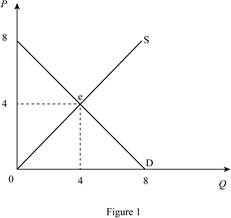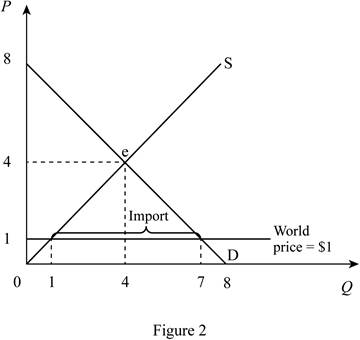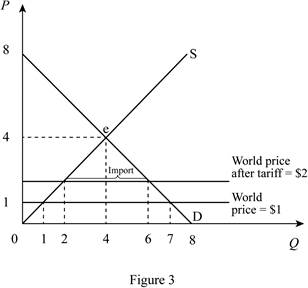
Subpart (a):
The equilibrium price and the quantity of haircuts and total surplus.
Subpart (a):
Explanation of Solution
Supply curve: The supply equation is

In Figure 1, horizontal axis measures quantity and vertical axis measures price. The curve D indicates demand and the curve S indicates supply. Market reaches the equilibrium at point ‘e’ where the demand curve intersects with supply curve.
Equilibrium price can be calculated as follows.
Equilibrium price is $4.
Thus, equilibrium quantity is 4 units.
Consumer surplus is $8.
Producer surplus is $8.
Total surplus can be calculated as follows.
Total surplus is $16.
Concept introduction:
Consumer surplus: It is the difference between the highest willing price of the consumer and the actual price that the consumer pays.
Producer surplus: It is the difference between the minimum accepted price for the producer and the actual price received by the producer.
Equilibrium price: It is the market price determined by equating the supply to the demand. At this equilibrium point, the supply will be equal to the demand and there will be no excess demand or
Subpart (b):
The equilibrium price and the quantity of haircuts and total surplus.
Subpart (b):
Explanation of Solution
The world price for the good is $1. Thus, when the country opens the market for trade, the price becomes $1 in domestic country too. Figure 2 describe this situation.

In Figure 2, horizontal axis measures quantity and vertical axis measures price. The curve D indicates demand and the curve S indicates supply. Market reaches the equilibrium at point ‘e’ where the demand curve intersects with supply curve.
When the competitor (Rest of the world) sells a good at price $1, in domestic country equilibrium price become equal to world price. Thus, equilibrium price in the domestic country is $1.
Equilibrium domestic supply can be calculated by substituting the domestic equilibrium price in to supply equation.
Thus, equilibrium quantity is 1 unit.
Equilibrium domestic demand can be calculated by substituting the domestic equilibrium price in to demand equation.
Thus, equilibrium domestic demand is 7 units.
Total imports can be calculated as follows.
Domestic imports are 6 units.
Consumer surplus can be calculated as follows.
Consumer surplus is $24.5.
Producer surplus can be calculated as follows.
Producer surplus is $0.5.
Total surplus can be calculated as follows.
Total surplus is $25.
Concept introduction:
Consumer surplus: It is the difference between the highest willing price of the consumer and the actual price that the consumer pays.
Producer surplus: It is the difference between the minimum accepted price for the producer and the actual price received by the producer.
Equilibrium price: It is the market price determined by equating the supply to the demand. At this equilibrium point, the supply will be equal to the demand and there will be no excess demand or excess supply in an economy. Thus, the economy will be at equilibrium.
Subpar (c):
The equilibrium price and the quantity of haircuts and total surplus.
Subpar (c):
Explanation of Solution
When domestic country impose tariff of $1, the price in domestic country increases from $1 to $2. This increase in price is shown in the Figure 3.

In Figure 3, horizontal axis measures quantity and vertical axis measures price. The curve D indicates demand and the curve S indicates supply. Market reaches the equilibrium at point ‘e’ where the demand curve intersects with supply curve. Price is increases from $1 to $2 due to the tariff of $1.
Domestic equilibrium price can be calculated as follows.
New domestic price is $2.
Equilibrium domestic supply can be calculated by substituting the domestic equilibrium price in to supply equation.
Thus, equilibrium quantity is 2 units.
Equilibrium domestic demand can be calculated by substituting the domestic equilibrium price in to demand equation.
Thus, equilibrium domestic demand is 6 units.
Total imports can be calculated as follows.
Domestic imports are 4 units.
Consumer surplus can be calculated as follows.
Consumer surplus is $18.
Producer surplus can be calculated as follows.
Producer surplus is $2.
Government revenue can be calculated as follows.
Government revenue is 4.
Total surplus can be calculated as follows.
Total surplus is $24.
Concept introduction:
Consumer surplus: It is the difference between the highest willing price of the consumer and the actual price that the consumer pays.
Producer surplus: It is the difference between the minimum accepted price for the producer and the actual price received by the producer.
Equilibrium price: It is the market price determined by equating the supply to the demand. At this equilibrium point, the supply will be equal to the demand and there will be no excess demand or excess supply in an economy. Thus, the economy will be at equilibrium.
Subpart (d):
Calculate total gains and deadweight loss.
Subpart (d):
Explanation of Solution
Total gains from opening up trade can be calculated as follows.
Total gains are$8.
Deadweight loss can be calculated as follows.
Deadweight loss is $1.
Want to see more full solutions like this?
Chapter 9 Solutions
Bundle: Principles of Microeconomics, 7th + LMS Integrated Aplia, 1 term Printed Access Card
- Environmental Economicsarrow_forwardEnvironmental Economicsarrow_forward1. The current price for a barrel of oil is $28. Assume the marginal extraction cost per barrel is $8 and the interest rate is 4 percent per year. a. According to the standard Hotelling model for a nonrenewable resource, what is the forecasted price for next year? b. How would your forecast change (qualitatively) if the demand for oil increased before next year?arrow_forward
- • What are the 5 positive and 5 negative attitudes a salesperson has? What are the best way to improve those negative attitudes? • What is the another concise definition of Salesmanship? • As a Watson's salesperson in the Philippines what are they're: - earning opportunities? - chances of promotion and career growth? - rewards and awards? - incentives and fringe benefits? - employment requirements?arrow_forwardWhere in the Victoria, BC is the most logging occurring? Include relative and absolute locationsarrow_forwardIn Foresty , What do most clear cut locations have in common with each other? Do they occur along the shorelines of lakes and rivers? Near major highways? Are they near cities or far from people?arrow_forward
- How sustainable is the forestry industry in BC in your opinion? Not at all, somewhat, very and explain your reasoning.arrow_forwardIn a paragraph, no bullet, points please answer the question and follow the instructions. Give only the solution: Use the Feynman technique throughout. Assume that you’re explaining the answer to someone who doesn’t know the topic at all. 6.Draw a standard Commercial Bank Balance Sheet and briefly explain each of the main components.arrow_forwardC1 The following model can be used to study whether campaign expenditures affect election outcomes: voteA = 0 + B₁ log(expendA) + ẞ₂ log(expendB) + ẞ3 prtystrA + u, where voteA is the percentage of the vote received by Candidate A, expendA and expend are campaign expenditures by Candidates A and B, and prtystrA is a measure of party strength for Candidate A (the percentage of the most recent presidential vote that went to A's party). == (i) (ii) (iii) (iv) What is the interpretation of B₁? In terms of the parameters, state the null hypothesis that a 1% increase in A's expenditures is offset by a 1% increase in B's expenditures. Estimate the given model using the data in VOTE1.DTA and report the results in usual form. Do A's expenditures affect the outcome? What about B's expenditures? Can you use these results to test the hypothesis in part (ii)? Estimate a model that directly gives the t statistic for testing the hypothesis in part (ii). What do you conclude? (Use a two-sided…arrow_forward
- In a paragraph, no bullet, points please answer the question and follow the instructions. Give only the solution: Use the Feynman technique throughout. Assume that you’re explaining the answer to someone who doesn’t know the topic at all. 10. What is Tinbergen’s constraint? Explain its importance in regard to US monetary policy.arrow_forwardIn a paragraph, no bullet, points please answer the question and follow the instructions. Give only the solution: Use the Feynman technique throughout. Assume that you’re explaining the answer to someone who doesn’t know the topic at all. 8. How does monetary policy supposedly translate into changes in AD?arrow_forwardIn a paragraph, no bullet, points please answer the question and follow the instructions. Give only the solution: Use the Feynman technique throughout. Assume that you’re explaining the answer to someone who doesn’t know the topic at all. 2. Carefully explain either Keynes’ “cookie jar” motive for holding money or the “saw-toothed model’s” motive for holding a safety stock.arrow_forward
 Principles of MicroeconomicsEconomicsISBN:9781305156050Author:N. Gregory MankiwPublisher:Cengage Learning
Principles of MicroeconomicsEconomicsISBN:9781305156050Author:N. Gregory MankiwPublisher:Cengage Learning Principles of Economics, 7th Edition (MindTap Cou...EconomicsISBN:9781285165875Author:N. Gregory MankiwPublisher:Cengage Learning
Principles of Economics, 7th Edition (MindTap Cou...EconomicsISBN:9781285165875Author:N. Gregory MankiwPublisher:Cengage Learning Principles of Macroeconomics (MindTap Course List)EconomicsISBN:9781285165912Author:N. Gregory MankiwPublisher:Cengage Learning
Principles of Macroeconomics (MindTap Course List)EconomicsISBN:9781285165912Author:N. Gregory MankiwPublisher:Cengage Learning Microeconomics: Private and Public Choice (MindTa...EconomicsISBN:9781305506893Author:James D. Gwartney, Richard L. Stroup, Russell S. Sobel, David A. MacphersonPublisher:Cengage Learning
Microeconomics: Private and Public Choice (MindTa...EconomicsISBN:9781305506893Author:James D. Gwartney, Richard L. Stroup, Russell S. Sobel, David A. MacphersonPublisher:Cengage Learning Macroeconomics: Private and Public Choice (MindTa...EconomicsISBN:9781305506756Author:James D. Gwartney, Richard L. Stroup, Russell S. Sobel, David A. MacphersonPublisher:Cengage Learning
Macroeconomics: Private and Public Choice (MindTa...EconomicsISBN:9781305506756Author:James D. Gwartney, Richard L. Stroup, Russell S. Sobel, David A. MacphersonPublisher:Cengage Learning Economics: Private and Public Choice (MindTap Cou...EconomicsISBN:9781305506725Author:James D. Gwartney, Richard L. Stroup, Russell S. Sobel, David A. MacphersonPublisher:Cengage Learning
Economics: Private and Public Choice (MindTap Cou...EconomicsISBN:9781305506725Author:James D. Gwartney, Richard L. Stroup, Russell S. Sobel, David A. MacphersonPublisher:Cengage Learning





